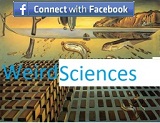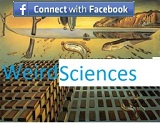Einstein’s Theory
In 1915 Einstein formulated a new theory of gravitation that reconciled the force of gravitation with the requirements of his theory of special relativity. He proposed that gravitational effects move at the speed of c. He called this theory general relativity to distinguish it from special relativity, which only holds when there is no force of gravitation. General relativity produces predictions very close to those of Newton’s theory in most familiar situations, such as the moon orbiting the earth. Einstein’s theory differed from Newton’s theory, however, in that it described gravitation as a curvature of space and time.
In Einstein’s general theory of relativity, he proposed that space and time may be united into a single, four-dimensional geometry consisting of 3 space dimensions and 1 time dimension. In this geometry, called spacetime, the motions of particles from point to point as time progresses are represented by curves called world lines. If there is no gravity acting, the most natural lines in this geometry are straight lines, and they represent particles that are moving always in the same direction with the same speed—that is, particles that have no force acting on them. If a particle is acted on by a force, then its world line will not be straight. Einstein also proposed that the effect of gravitation should not be represented as the deviation of a world line from straightness, as it would be for an electrical force. If gravitation is present, it should not be considered a force. Rather, gravitation changes the most natural world lines and thereby curves the geometry of spacetime. In a curved geometry, such as the two-dimensional surface of the earth, there are no straight lines. Instead, there are special curves called geodesics, an example of which are great circles around the earth. These special curves are at each point as straight as possible, and they are the most natural lines in a curved geometry. The effect of gravitation would be to influence the geodesics in spacetime. Near sources of gravitation the space is strongly curved and the geodesics behave less and less like those in flat, uncurved spacetime. In the solar system, for example, the effect of the sun and the earth is to cause the moon to move on a geodesic that winds around the geodesic of the earth 12 times a year.
A. Testing Einstein’s Theory: Einstein’s theory required verification, but the level of precision in measurement needed to distinguish between Einstein’s theory and Newton’s theory was difficult to achieve in the early 20th century and remains so today. There were two predictions, however, that could be tested. One involved deviations in the orbit of Mercury. Astronomers had observed that the ellipse of Mercury’s orbit itself rotated—that is, the point nearest the sun, called the perihelion, slowly advanced around the sun. The rate of advancement predicted by Newton’s theory differed slightly from what astronomers had measured, but Einstein’s theory predicted the correct rate.
The second test involved measuring the bending of light as it passed around the sun. Both Newton’s and Einstein’s theories predicted that light would be deflected by gravitation. But the amount of deflection predicted by the two theories differed. The light to be measured in such a test originates in distant stars. However, under ordinary conditions the sun’s brightness prevents scientists from observing the light from these stars. This problem disappears during an eclipse, when the moon blocks the sun’s light. In 1919 a special British expedition took photographs during an eclipse. Scientists measured the deflection of starlight as it passed by the sun and arrived at numbers that agreed with Einstein’s prediction. Subsequent eclipse observations also have confirmed Einstein’s theory.
Other physicists have proposed relativistic theories of gravitation to compete with Einstein’s. In these competing theories, almost all of which are geometrical like Einstein’s, gravitational effects move at the speed c. They differ mostly in the mathematical details. Even using the technology of the late 20th century, scientists still find it very difficult to test these theories with experiments and observations. But Einstein’s theory has passed all tests that have been made so far.
B. Applications of Einstein’s Theory: Einstein’s general relativity theory predicts special gravitational conditions. The Big Bang theory, which describes the origin and early expansion of the universe, is one conclusion based on Einstein’s theory that has been verified in several independent ways.
Another conclusion suggested by general relativity, as well as other relativistic theories of gravitation, is that gravitational effects move in waves. Astronomers have observed a loss of energy in a pair of neutron stars (stars composed of densely packed neutrons) that are orbiting each other. The astronomers theorize that energy-carrying gravitational waves are radiating from the pair, depleting the stars of their energy. Very violent astrophysical events, such as the explosion of stars or the collision of neutron stars, can produce gravitational waves strong enough that they may eventually be directly detectable with extremely precise instruments. Astrophysicists are designing such instruments with the hope that they will be able to detect gravitational waves by the beginning of the 21st century.
Another gravitational effect predicted by general relativity is the existence of black holes. The idea of a star with a gravitational force so strong that light cannot escape from its surface can be traced to Newtonian theory. Einstein modified this idea in his general theory of relativity. Because light cannot escape from a black hole, for any object—a particle, spacecraft, or wave—to escape, it would have to move past light. But light moves outward at the speed c. According to relativity, c is the highest attainable speed, so nothing can pass it. The black holes that Einstein envisioned, then, allow no escape whatsoever. An extension of this argument shows that when gravitation is this strong, nothing can even stay in the same place, but must move inward. Even the surface of a star must move inward, and must continue the collapse that created the strong gravitational force. What remains then is not a star, but a region of space from which emerges a tremendous gravitational force.







Only two years left before 2012. It is time to stack up on preservative foods that would normally kill us any other day. But since the world is ending anyway we would need anything that would preserve us until the aliens come to take us to their planet to put probes up our butts.